Christine Valters Paintner's Blog, page 87
October 30, 2018
Monk in the World Guest Post: Barb Morris
I am delighted to share another beautiful submission to the Monk in the World guest post series from the community. Read on for Barb Morris' reflection on the Hospital of the Soul.
This is a story of following hunches, nudges, and breadcrumbs dropped by the Holy Spirit.
I found El Hospital del Alma on a cold, rainy day on the Camino. El Hospital del Alma, “Hospital of the Soul,” is in Castrojeriz, along the Camino de Santiago, on the vast, interior Spanish plateau called the Meseta. The Camino Francés begins in the beauty of Navarra and Rioja among the Pyrenees, rolling hills, rivers, and vineyards. The Camino ends in the beauty of Galicia, with its mountain ranges, deep green fields, and rainbows. In between is the Meseta – arid, flat, monotonous, and seemingly endless.
The two weeks in May that we spent walking across the Meseta were unusually cold and wet.
El Hospital del Alma was a welcome refuge at the end of a long, wet slog of a day along muddy paths and rocky roads. Finding it was an accident. Most pilgrims walk through Castrojeriz unaware of El Hospital del Alma’s existence. After our usual post-walk showering and laundry routine, we went in search of our usual post-walk beer and tapas. I don’t remember now why we departed from the main route through Castrojeriz. Then, there it was – The Hospital of the Soul. I knew immediately that I needed this place, especially the sunroom with its glass ceiling, warm wood stove, quiet music, and soft furniture. The artist owner provided strawberries, cookies, and tea. Other pilgrims soaked in the gift of this house with its brightly painted rooms, bookshelves, colorful fabrics, and photographs.
And its warmth. Oh, its warmth.
My journal entry for that day reads, in part, “I have found my life’s work on day 16 of my Camino. This is surprising to me .… I’m constantly astounded these days – by how much I walk, by the beauty around me, by my strength …. I felt a total, complete soul hit the moment I walked in here …. My 'job' is to create a space like this – art, photography, poetry, books, funky simple beauty – to open it to people who need it. Who crave it like I am craving it. This makes no intellectual sense.”
As a step in following my soul’s irrational guidance, I now offer regular Hospital del Alma opportunities. I provide tea and cookies as retreatants arrive and settle in. We open our time with community Lectio Divina. (I use Abbess Christine’s book Lectio Divina as a guide.) After Lectio, some participants choose silence while others stay and talk. Then we come together for facilitated conversation about a specific topic, usually an outgrowth of Lectio. A simple soup and bread lunch ends our time together.
I continue to be surprised by our Hospital of the Soul. Here’s one example. Last month, rather than picking a piece of poetry or scripture based on a hunch or yearning as I usually do, I went “hard-core monastic” and used the gospel appointed for the day from the Episcopal Church’s daily lectionary readings. I consulted a reliable source, Forward Day by Day, for the reading, which was Matthew’s account of the feeding of the five-thousand (Matthew 14: 13 – 21).
One of our regular participants is a practicing Quaker. Another has a profound discomfort with organized religion. All of us have some qualms about church. There was a little unease in the room when I announced the text.
In Matthew’s account of this story, Jesus has just heard that Herod has beheaded John, and he goes away to a deserted place. The crowd, “about five thousand men, plus women and children,” gets wind of Jesus’ whereabouts, and they follow. What does Jesus do? I imagine him wiping away his tears and indulging in a sigh of exasperation before he gets to work. As Matthew puts it, Jesus “had compassion on them and cured their sick.” He teaches and heals. And then he feeds the people. Or, rather, he tells his disciples to feed the people.
When our group listens deeply to a text in the container of Lectio, we typically hear different things. Last month, however, we all heard variations on the same theme. We are, here in the United States, living with a government doing brutal things. We were just beginning to learn of our president’s policy to separate children from their parents at our southern border. Our take-away, to a woman, was that in the face of evil acts, our task is to stay faithful to our calling – to teach, heal, and feed. To choose compassion and generosity, over and over again, just as Jesus did. Like Jesus, we wanted to withdraw to a deserted place. And, following Jesus, we will instead respond to the needs of a hurting world, trusting in the sufficiency and mercy of God.
Here’s another surprise. Forward Day by Day had the wrong gospel listed that day. They were a week early with Matthew’s feeding of the five thousand. It’s the only time I’ve known the editors to make an error.
The reading was incorrect, and the reading was perfect for us.
My husband’s desire to walk the Camino led me to El Hospital del Alma, which led to gatherings of women seeking a healing space for themselves and others, which led to deep reading in community Lectio. Holy breadcrumbs, followed faithfully, lead to healing and wholeness for us as individuals and for the world in which we live.
 Barb Morris is a life coach, teacher, and retreat facilitator living in Bend, Oregon with her Episcopal priest husband. They walked the Camino de Santiago in 2014, and the trails of Central Oregon as often as they can. Connect with her at www.barbmorris.com.
Barb Morris is a life coach, teacher, and retreat facilitator living in Bend, Oregon with her Episcopal priest husband. They walked the Camino de Santiago in 2014, and the trails of Central Oregon as often as they can. Connect with her at www.barbmorris.com.
October 28, 2018
Celtic Conversations with Pius Murray
 I am delighted to introduce a new podcast series, Celtic Conversations, inspired by my new book – The Soul's Slow Ripening: 12 Celtic Practices for Seeking the Sacred – and my time living in Ireland. I am hosting a series of conversations with authors, artists, and guides about Celtic spirituality. So find a cozy space and pour yourself a cup of tea.
I am delighted to introduce a new podcast series, Celtic Conversations, inspired by my new book – The Soul's Slow Ripening: 12 Celtic Practices for Seeking the Sacred – and my time living in Ireland. I am hosting a series of conversations with authors, artists, and guides about Celtic spirituality. So find a cozy space and pour yourself a cup of tea.
My guest today is Pius Murray and we had a delightful conversation about a more embodied way of being, presence in the landscape, the story of St. Colman and his time as a hermit, Pilgrim Paths Ireland, slowing down to see ("all rushing is violence"), rituals he leads on his spiritual walks, the gifts of poetry, transitional spaces and thresholds, and cultivating awareness of wow moments.

 Pius Murray N.T., B.A., H.D.E.(Hons.), LL.B.(Hons.), Diploma in Celtic Spirituality has his own guided walks business,
Walk With Pius
. He is a founder member of
Pilgrim Paths Ireland
and a member of the
Burren Ecotourism Network
. He is a member of the Burrenbeo Trust and a Burren Conservation Volunteer.
Pius Murray N.T., B.A., H.D.E.(Hons.), LL.B.(Hons.), Diploma in Celtic Spirituality has his own guided walks business,
Walk With Pius
. He is a founder member of
Pilgrim Paths Ireland
and a member of the
Burren Ecotourism Network
. He is a member of the Burrenbeo Trust and a Burren Conservation Volunteer.He organises and leads walks, especially Inspirational Walks which enable walkers to connect with nature and with the spirituality of the landscape in the Burren and on Inisheer, for visitors of all nationalities, students of all levels and a variety of associations and organisations. Pius lives in Corofin, County Clare with his wife and family.

Pius shared this beautiful blessing to begin our time together:
I arise today
Through the strength of heaven;
Light of the sun,
Radiance of the moon,
Splendor of fire,
Speed of lightning,
Swiftness of the wind,
Depth of the sea,
Stability of the earth,
Firmness of the rock.
I will this day.
—St. Patrick's Breastplate Prayer (excerpt)
*Opening music track is an excerpt from Simon DeVoil's song "Water" on his album Heart Medicine (used with kind permission)
October 27, 2018
Join us for Honoring Saints and Ancestors (an online retreat) ~ A Love Note from Your Online Abbess
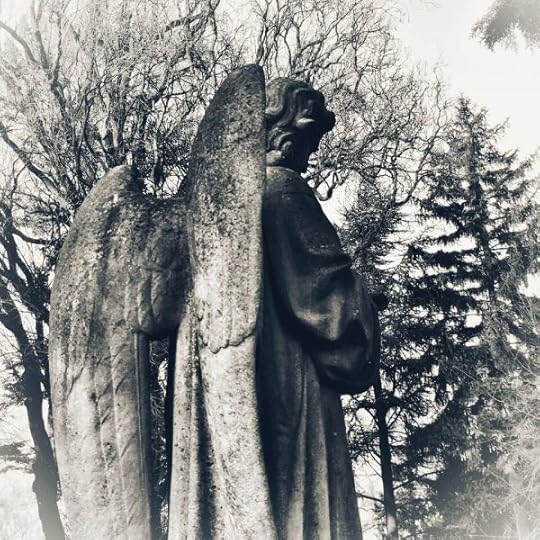 Inheritance
Inheritance
I take down the generic
white jug from the shelf,
the one made with ten thousand
others in a factory in Taiwan.
I wish it were the Meissen porcelain one
with the blue onion pattern that survived
two world wars, but not my need
for funds to finish graduate school.
I long, too, for the cut crystal bowl,
etched with delicate flowers
in which you served ripe, sweet berries
but was later sold to pay for books.
Or the silver set with your initials
engraved on the handles, I imagine
a stranger now running her fingers along
the grooves those letters make.
I only held onto the coffee cups from which
you sipped your Kaffee in the afternoons,
a slow pause in the day, your eyes looking
far into the distance.
—Christine Valters Paintner (first published in Skylight 47)
Dearest Monks, artists, and pilgrims,
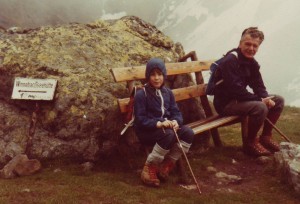 The photo is of me as a young girl sitting with my father on a bench in the Austrian Alps, taking a break from one of the many hikes we took together in the summers. I have shared some of my journey with him here before – his layers of addiction, his inability to offer unconditional love, his narrowness of vision. This is a part of my inheritance that I continue to name and own. His grief and despair flow through me, rising and falling like the tide, and I make space for them within me.
The photo is of me as a young girl sitting with my father on a bench in the Austrian Alps, taking a break from one of the many hikes we took together in the summers. I have shared some of my journey with him here before – his layers of addiction, his inability to offer unconditional love, his narrowness of vision. This is a part of my inheritance that I continue to name and own. His grief and despair flow through me, rising and falling like the tide, and I make space for them within me.
Joy and wonder are there too. I hold the objects that belonged to him like a talisman pressed into my palm, pointing me in the direction of a wide landscape of unlived possibility. I follow this compass for him and for all of my ancestors who were bound by fear and a rejection of their deepest longings. I live into my own delight for his healing and for my own.
My father died 22 years ago. Several summers ago I journeyed to Latvia, the land of his birth, a place he had to flee at age twelve, not knowing he would never return again. There I encountered the vulnerable little boy he once was. A boy who walked barefoot along the edges of the Baltic Sea, whose heart must once have been as wide as the ocean and raced with excitement in his chest in wonder at the beauty of it all. And I discovered he is still very much alive, running across hot summer sand, relishing the cool breeze through his damp hair, arms spread wide, eyes closed, turning slowly. In quiet moments I turn with him, revolving around a stillpoint within, and I hear him whispering that he is free, that I am free.
If you want to make time and space for remembrance of those who have walked before you, please join us for our online retreat Honoring Saints and Ancestors (starts tomorrow!)
With great and growing love,
Christine
Christine Valters Paintner, PhD, REACE
October 23, 2018
Monk in the World Guest Post: Jamie Marich
I am delighted to share another beautiful submission to the Monk in the World guest post series from the community. Read of for Jamie Marich's reflection "Jerusalem."
I can fit the old city
In the palm of my hand
From where I stand
On the Mt. of Olives
Oh, Jerusalem—
The vision of what
Spirituality could be
And yet religion divides you
Religion causes war
Religion tears people to shreds
Because everyone believes
Their word to be the holiest
Yet as I hold Jerusalem
In the palm of my hand
I know that the Holy of Holies
Lives inside of me
All of this beauty will not last
And if the last war destroys the last building
True holiness remains
In the hearts of those left to bear witness
During my first trip to Israel in June 2018, I had the privilege of meeting two individuals who shared key insights with me. The first was Alexandra Cohen, a Jewish woman I met through common friends of ours in a yoga community to which we both belong. Alexandra (Arti) is a teacher and a writer who lives in Israel. In a riveting conversation that took place on a Saturday night in Haifa, she shared this magnificent reflection about the Holy of Holies as something that exists within us. Her teaching on the Holy of Holies corresponds with a core truth of yoga, specifically emphasized in the lineage in which we study. As she observes in her teaching, so much of the conflict and bloodshed is about where the external expression of the Holy calls home.
Is bloodshed and conflict among peoples inevitable unless we recognize that the Divine is within us? Does fear drive us to do insane things to each other because we somehow fear that we’re missing out on something? Something magical, mystical, special, and chosen? As I travelled to Jerusalem and toured through the sacred city the following day, the questions prompted by Alexandra’s insights stirred within me. I hope that my new friend continues to share her ideas on this with the world because in them, I believe, exists a pathway to greater peace and enlightenment.
The next evening at sunset, a Palestinian taxi driver named “Jimmy” offered to take me up to the Mt. of Olives, the famous place where Jesus prayed on Holy Thursday before he was arrested. Jimmy told me, “It’s the best view in all of Jerusalem. You can really hold the whole city in the palm of your hand.” And when I got out of the cab to take in the view shown in my pictures, I was amazed. I extended my hand and discovered that the entirety of the Old City rested on my palm. I was so glad I accepted this offer to take in the view. Experiencing Jerusalem in the palm of my hand is an experience I can never forget. As I engaged in that practice, I savored a wild sense of integration about what Jimmy taught me and what Alexandra taught me. I am a Catholic-Christian by heritage and in meeting both Israeli and Palestinian people on my journey, so many of the dots about my spiritual journey connected. What I learned was so overwhelming I found it difficult to put into an essay or any more substantive discourse. I hope that this poem and these pictures offer you a glimpse into my internal process of engaging with the Holy Land, its complexities, its perils, and its wonders. How you engage with Jerusalem may teach you more about yourself than you ever realized.
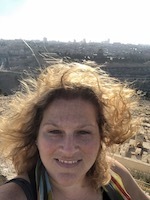 Jamie Marich, Ph.D., LPCC-S, LICDC-CS, REAT, RMT travels internationally speaking on topics related to EMDR therapy, trauma, addiction, expressive arts and mindfulness while maintaining a private practice in her home base of Warren, OH. She is the developer of the Dancing Mindfulness practice (www.dancingmindfulness.com). Jamie is the author of four books, including the popular EMDR Made Simple. She is co-author with Dr. Stephen Dansiger on her most recent book, EMDR Therapy and Mindfulness for Trauma Focused Care.
Jamie Marich, Ph.D., LPCC-S, LICDC-CS, REAT, RMT travels internationally speaking on topics related to EMDR therapy, trauma, addiction, expressive arts and mindfulness while maintaining a private practice in her home base of Warren, OH. She is the developer of the Dancing Mindfulness practice (www.dancingmindfulness.com). Jamie is the author of four books, including the popular EMDR Made Simple. She is co-author with Dr. Stephen Dansiger on her most recent book, EMDR Therapy and Mindfulness for Trauma Focused Care.
October 21, 2018
Celtic Conversations with Jenny Beale
 I am delighted to introduce a new podcast series, Celtic Conversations, inspired by my new book The Soul's Slow Ripening: 12 Celtic Practices for Seeking the Sacred and my time living in Ireland. I am hosting a series of conversations with authors, artists, and guides about Celtic spirituality. So find a cozy space and pour yourself a cup of tea. (Also available at Soundcloud, Stitcher and iTunes).
I am delighted to introduce a new podcast series, Celtic Conversations, inspired by my new book The Soul's Slow Ripening: 12 Celtic Practices for Seeking the Sacred and my time living in Ireland. I am hosting a series of conversations with authors, artists, and guides about Celtic spirituality. So find a cozy space and pour yourself a cup of tea. (Also available at Soundcloud, Stitcher and iTunes).
My guest today is Jenny Beale and we had a delightful conversation about finding Celtic spirituality in New Zealand, St. Brigit of Kildare and her goddess tradition, the story of Brigit and her cloak, sacredness of the landscape, the four Celtic festivals, the inspiration behind building Brigit's Garden, the gifts of winter, and the saging process.

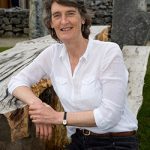 Jenny Beale has always found inspiration in the natural world and is particularly interested in the intersection between Celtic spirituality and nature. Fifteen years ago she founded Brigit’s Garden in the West of Ireland, a Celtic-themed garden celebrating the Brigit tradition. Brigit’s Garden is a place of tranquillity, closeness to nature and environmental education, and welcomes pilgrimage and other groups from all over the world.
Jenny Beale has always found inspiration in the natural world and is particularly interested in the intersection between Celtic spirituality and nature. Fifteen years ago she founded Brigit’s Garden in the West of Ireland, a Celtic-themed garden celebrating the Brigit tradition. Brigit’s Garden is a place of tranquillity, closeness to nature and environmental education, and welcomes pilgrimage and other groups from all over the world.

Jenny shared this beautiful traditional blessing to begin our time together:
May the road rise with you
may the wind be always at your back
may the sun shine warm upon your face
and the rain fall softly on your fields
until we meet you may God hold you in the hollow of God's hand.
*Opening music track is an excerpt from Simon DeVoil's song "Water" on his album Heart Medicine (used with kind permission)
October 20, 2018
Remembering Those Who Walked Before Us ~ A Love Note from Your Online Abbess
 Dearest monks, artists, and pilgrims,
Dearest monks, artists, and pilgrims,
We are approaching the Celtic feast of Samhain, the great doorway into the dark half of the year in the northern hemisphere and a time when the veil is considered especially thin. This is my favorite time of year, when I feel the most energized and my heart comes alive to the wisdom of those who have walked before me. I share with you a short excerpt from our upcoming Honoring Saints and Ancestors online retreat:
Psychologist Carl Jung wrote extensively about the collective unconscious which is this vast pool of ancestral memory within each of us, it is a kind of deposit of ancestral experience. He believed it comprises the psychic life of our ancestors right back to the earliest beginnings, nothing is lost, all of the stories, struggles, and wisdom are available to us. Each of us is an unconscious carrier of this ancestral experience and part of our journey is to bring this to consciousness in our lives.
He even believed it comprises our animal ancestry which existed longer in time than our human existence. It is the place where archetypes emerge – those symbols and experiences that appear across time and cultures. The stories of our ancestors are woven into the fabric of our very being. As the poet May Sarton writes: “Now the dead move through all of us still glowing. . . What has been plaited cannot be unplaited . . . and memory makes kings and queens of us.”
Jung wrote:
I became aware of the fateful links between me and my ancestors. I feel very strongly that I am under the influence of things or questions which were left incomplete or unanswered by my parents and grandparents and more distant ancestors. It often seems as if there were an impersonal karma within a family, which is passed on from parents to children. It has always seemed to me that I had to answer questions which fate had posed to my forefathers, and which had not yet been answered, or as if I had to complete, or perhaps continue, things which previous ages had left unfinished.
The invitation for this season ahead is to remember and honor these stories which live inside of us, many of them unfinished or incomplete. We let the “lost human voices speak through us” and perhaps discover our own deepest longings are woven together with theirs. Consider spending some time in your journal holding this image of offering space for the lost human voices of your ancestors to speak. What stories might they tell? What wisdom might they offer?
With great and growing love,
Christine
Christine Valters Paintner, PhD, REACE
Photo © Christine Valters Paintner
October 16, 2018
Monk in the World Guest Post: Kathryn Coneway
I am delighted to share another beautiful submission to the Monk in the World guest post series from the community. Read on for Kathryn Coneway's reflection on being a monk and artist.
I want to start living like a monk…
quiet, listening
feeling patterns – from the drum of heartbeat
to the timber of voice
and the cadence of speech
Waking early becomes less a chore
and more a sacred rhythm
The dog’s eager animal companionship
guides me to a friend for the journey
to move, to begin, to be aware
in the pre-dawn hours.
A moving into the world
rather than away –
taking with me an inner rhythm –
my touchstones, breathing,
pausing to see the patterns,
points of connection.
I am going to start living like an artist…
Well, yes,
but maybe out loud
this time,
a bit less hidden
Remembering
I am
following
an ancient path.
Tapping into the old way,
into wisdom.
Deep and worn smooth
by the touch of hands,
High touch,
seeking connection
The art of living, making,
and learning
to frame my practice
Art is a way to newness
around each bend
openness to begin
and to see where the practice leads,
to invite others on the journey
to share vision.
I want to start living like a mystic…
full of wonder, curiosity, awe
to let dreams weave between
black branches
and to stand tall
and in contrast
like that white-barked tree
I want to come out of hiding
without feeling I must DO
something to earn my place
My place is reverence,
attention,
eye contact,
soft voices,
space for now to happen,
to be discovered anew.
I wrote this poem several years ago, the first time I read The Artist’s Rule. I was in a time of transition, having just closed an art studio I ran for the previous seven years and looking to make more time for my artist self and my own creative practice. Part of my self reflection during this time was realizing how well I framed space for others to do creative work and to share and how much I also needed to find a way to frame that space for my own practice.
The identities of monk, artist and mystic spoke to me then and continue to do so. My journey as an artist continues to evolve but today it includes more time for my own creative practice as well as work in community with leading groups in exploring the sacred space created through shared creative practice.
My personal mission statement for my work is as follows and grows out of pieces of the identities of monk, artist and mystic in my poem:
A studio is a sacred space – a space to explore and form relationships with materials, with others and with a deeper sense of self. The act of making quiets the mind, invites us to be fully present and opens us up to connections. Moments of connection spark curiosity, wonder, gratitude, and the urge to share what we discover. Sometimes we leave traces in images and objects we make; other times are more fleeting and leave their mark in new ways of seeing, empathy for another or a feeling of groundedness and connection to something greater. Community helps hold and tend this space – a creative and spiritual home for solitude as well as shared experience.
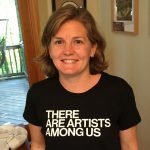 Kathryn is most energized by how community forms around creative practice. A practicing artist, she focuses on collages inspired by time spent in nature and on creating color wheels as a contemplative practice. Through her business, Art at the Center, she conducts teacher training and workshops for community groups on artistic practice. She is the author of two children’s books and creates miniature labyrinths for Art-o-mat, a program that converts retired cigarette machines into art vending machines. A role dear to her heart is directing art camp at Shrine Mont Camps for the Episcopal Diocese of Virginia. More of Kathryn’s art and writing can be found on her website, www.kathrynconeway.com
Kathryn is most energized by how community forms around creative practice. A practicing artist, she focuses on collages inspired by time spent in nature and on creating color wheels as a contemplative practice. Through her business, Art at the Center, she conducts teacher training and workshops for community groups on artistic practice. She is the author of two children’s books and creates miniature labyrinths for Art-o-mat, a program that converts retired cigarette machines into art vending machines. A role dear to her heart is directing art camp at Shrine Mont Camps for the Episcopal Diocese of Virginia. More of Kathryn’s art and writing can be found on her website, www.kathrynconeway.com
October 14, 2018
Celtic Conversations with Carl McColman
 I am delighted to introduce a new podcast series, Celtic Conversations, inspired by my new book The Soul's Slow Ripening: 12 Celtic Practices for Seeking the Sacred and my time living in Ireland. I am hosting a series of conversations with authors, artists, and guides about Celtic spirituality. So find a cozy space and pour yourself a cup of tea. (Also available at Soundcloud, Stitcher and iTunes).
I am delighted to introduce a new podcast series, Celtic Conversations, inspired by my new book The Soul's Slow Ripening: 12 Celtic Practices for Seeking the Sacred and my time living in Ireland. I am hosting a series of conversations with authors, artists, and guides about Celtic spirituality. So find a cozy space and pour yourself a cup of tea. (Also available at Soundcloud, Stitcher and iTunes).
My guest today is Carl McColman and we had a delightful conversation about a universal Celtic spirituality, the three strands of the tradition, a third way that embraces pagan roots and Christian branches, our incarnate and transcendent human nature, hospitality, "at the edge of waiting," threshold experiences, and the practice of storytelling.

Carl McColman is a contemplative writer, speaker, retreat leader, catechist and spiritual companion. He is the author of several books, including Befriending Silence, Answering the Contemplative Call, and The Big Book of Christian Mysticism. He is a life-professed Lay Cistercian (a layperson under formal spiritual guidance of Cistercian monks) affiliated with the Trappist Monastery of the Holy Spirit in Conyers, Georgia. He also received formation in the practice of Christian spirituality and contemplative leadership through the Shalem Institute for Spiritual Formation.
Carl regularly leads retreats and speaks on the contemplative life at monasteries and retreat centers, cathedrals, parishes and seminaries. His ministry is ecumenical in scope, and he has also participated in a number of interfaith initiatives. He maintains a website, blogs for Patheos, and is the co-host of a podcast, Encountering Silence.
About his ministry, Carl says, “I help Christians and other seekers respond to the healing love of God through prayer, silence, and discernment, so to embody a joyful life of creativity, service and delight.” He does this by passionately encouraging his audience to embrace contemplative spirituality, to drink from the deep wells of Christian wisdom beginning with scripture and the wisdom of saints and mystics, and to apply such insight to the challenges and concerns of everyday life.
His newest book, An Invitation to Celtic Spirituality: A Little Guide to Mystery, Spirit, and Compassion, will be published this November 2018 by Hampton Roads Publishing.
Carl McColman lives near Atlanta, GA. In addition to his blog, he is active on social media, including Facebook and Twitter.

Carl shared this beautiful poem by Billy Collins to begin our time together:
Design
I pour a coating of salt on the table
and make a circle in it with my finger.
This is the cycle of life
I say to no one.
This is the wheel of fortune,
the Arctic Circle.
This is the ring of Kerry
and the white rose of Tralee
I say to the ghosts of my family,
the dead fathers,
the aunt who drowned,
my unborn brothers and sisters,
my unborn children.
This is the sun with its glittering spokes
and the bitter moon.
This is the absolute circle of geometry
I say to the crack in the wall,
to the birds who cross the window.
This is the wheel I just invented
to roll through the rest of my life
I say
touching my finger to my tongue.
—Billy Collins, “Design” from The Art of Drowning. Copyright © 1995 by Billy Collins
*Opening music track is an excerpt from Simon DeVoil's song "Water" on his album Heart Medicine (used with kind permission)
October 13, 2018
Harvesting the Gifts ~ A Love Note from Your Online Abbess
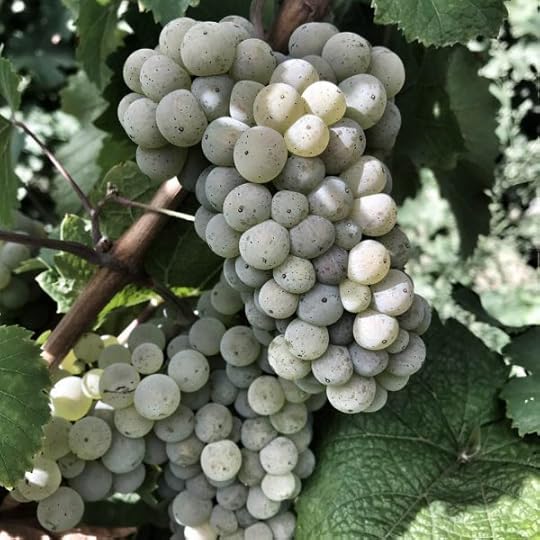 Dearest monks, artists, and pilgrims,
Dearest monks, artists, and pilgrims,
It is a very full season of life for me right now, having facilitated our Writing on the Wild Edges retreat at the end of August with John here in Ireland, then traveled to Germany to lead our pilgrimage in the footsteps of St. Hildegard of Bingen with Betsey Beckman (we are looking at fall 2021 for the next offering of that program). In a couple of days John and I have a new group arrive to Galway where we will journey to local sacred ruins and explore the gift that Celtic monasticism has for our lives. Then in November we travel together to Vienna, Austria, a city so close to my heart, to lead another monastic pilgrimage to the beautiful sites and monasteries there. My heart is so full with wonder at the work I am blessed to do.
Having led retreats for close to 25 years now and offering pilgrimages for the last five years, there is an ease and a joy that rises while also having the privilege of getting to know so many amazing dancing monks. Truly, the people who show up for our programs give me tremendous hope for our fractured world. People of great kindness, presence, commitment, and creative vision. I cherish my role in being present for one small part of the journey, and I know how much travel and pilgrimage has the potential to transform hearts and lives as it has done for my own.
I am so delighted with the wonderful reception my newest book The Soul’s Slow Ripening: 12 Celtic Practices for Seeking the Sacred has been receiving (special thank you to everyone who has written an Amazon review!) This book feels very much like a harvest of my time living here in Ireland for the past six years, a book I could not have written without my lived experience of the land and her people. I am also working with Paraclete Press currently on my collection of poems, Dreaming of Stones, which will be out next February/March 2019. This also feels like a rich harvest of my life here where I have found such a thriving and supportive community of poets. Even with all of the nonfiction books I have written, a poetry collection feels like an extra special thing.
Next spring our Ireland pilgrimages are almost full – two pilgrimages and two writing retreats, one of which is a brand new program I am thrilled to be offering in collaboration with two beautiful souls who live here in Ireland as well. Get in touch if you would like to register for the remaining spaces. I will also be traveling back to Seattle to lead a writing retreat (also full) and present at the Spiritual Directors International conference, which I am sure will feel like a coming home on many levels, even though the Pacific Northwest is no longer where I live, it lives in me in many ways. Then the spring will be capped off by leading a poetry retreat in Chartres, France where we will have the opportunity to walk the labyrinth in the cathedral, something I have always dreamed of doing. Please consider joining me there!
Then begins our year of sabbatical, a Jubilee year because it will be our fiftieth year of life for both of us (John and I are born a day apart). More details to come about how that looks for the Abbey (not to worry, email newsletters will continue). In talking with someone last spring about how to plan for the Jubilee year, especially in financial terms, she shared that she hoped my year of planning would be woven through with the spirit of Jubilee itself. And that has definitely been the case as I anticipate what that year of rest and time for focused writing might bring to me. It brings me that much more gratitude for the gift of work to sustain us now.
We are approaching the time of the ancestors. Honoring my own ancestral line continues to be a significant part of my own spiritual practice. Every year we offer a short online retreat to practice this together in community (details here and the early registration discount ends tomorrow). It is rich work, a path of deep healing and opening up to the immense love and support we have behind each of us. I have been calling on my grandmothers and grandfathers to guide me through the fullness of this time and to help me prepare for our sabbatical with wisdom and grace.
October is my favorite month because of the quality of evening light which shimmers golden and radiant as each day comes to a close. I love the autumn for its call to release what does not serve but also to celebrate the harvest of my life. Recently the word “surplus” has been calling to me to sit with it again. Surplus for me means not just keeping my life sustainable in terms of energetic demands, but to seek ways to welcome in an overflowing of energy and capacity to meet the demands of the world.
What are you harvesting right now dear monks? What gifts are being offered back to you after years of experience and dedication? Where are you finding glimpses of the surplus of your life?
With great and growing love,
Christine
Christine Valters Paintner, PhD, REACE
Photo © Christine Valters Paintner
October 11, 2018
Call for Submissions: Monk in the World Guest Posts
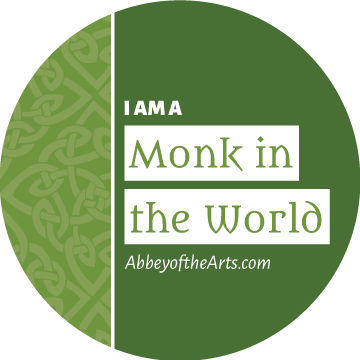
We welcome you to submit your reflection for possible publication in our Monk in the World guest post series. It is a gift to read how ordinary people are living lives of depth and meaning in the midst of the challenges of real life.
There are so many talented writers and artists in this Abbey community, so this is a chance to share your perspective. The link to the reflection will be included in our weekly newsletter which goes out to thousands of subscribers.
Please follow these instructions carefully:
Please click this link to read a selection of the posts and get a feel for the tone and quality.
Submit your own post of 700-900 words on the general theme of "How do I live as a monk in the world? How do I bring contemplative presence to my work and/or family?" It works best if you focus your reflection on one aspect of your life or a practice you have, or you might reflect on how someone from the monastic tradition has inspired you. We invite reflections on the practice of living contemplatively.
Please include a head shot and brief bio written in the third person (50 words max). You are welcome to include 1-2 additional images if they help to illustrate your reflection in meaningful ways. All images should be your own. Please make sure the file size of each the images is smaller than 1MB. You can resize your image for free here.
We will be accepting submissions between now and December 5th for publication sometime in the winter and spring of 2019 and beyond (depending on the number of submissions). We reserve the right to make edits to the content as needed (or to request you to make edits) and submitting your reflection does not guarantee publication on the Abbey blog, but we will do our best to include as many of you as possible.
Email your submission to Melinda by December 5th and include the reflection pasted into the body of your email and attach your photo(s).
We will be back in touch with you at the latest by the middle of January to let you know if your post is accepted, if edits are needed, and/or when we have scheduled your post to appear.



